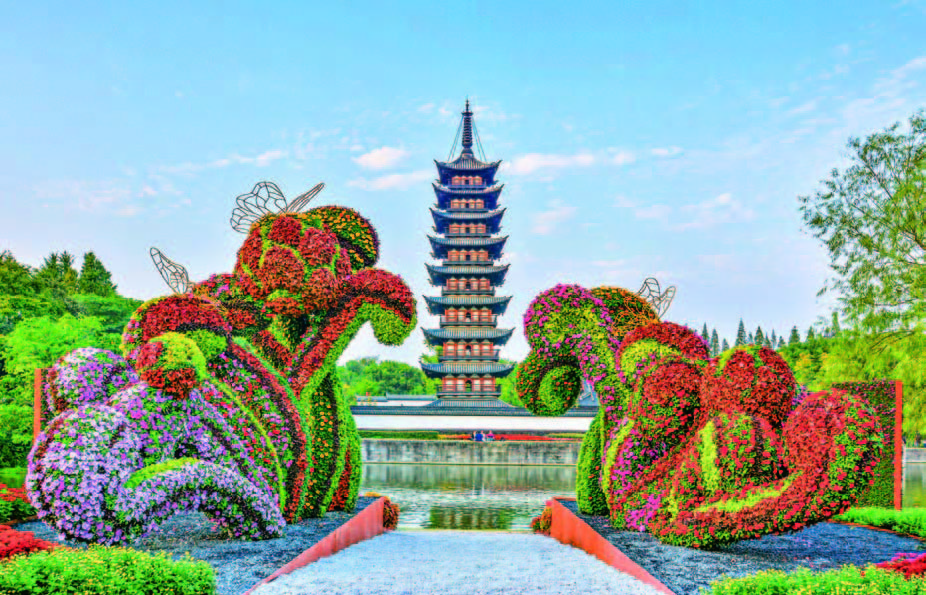

遇见·历史名城

The leaning angle of the 900-year-old Tianma Pearl Tower in Songjiang is greater than that of the Leaning Tower of Pisa in Italy.
The soaring skyscrapers of Pudong District showcase the growth of modern Shanghai. The stocky buildings of the Bund bear witness to the hundred-year vicissitudes of the oriental metropolis. Meanwhile, Songjiang points to Shanghai's millennia of history.
Archaeological discoveries in Songjiang proved that people inhabited the Guangfulin area of Songjiang as early as 6,000 years ago. During the Ming and Qing dynasties (1368-1912), Songjiang was the center of the country's textile industry and was dubbed the "Metropolis of the Southeast". Before Shanghai opened its ports in 1843, Songjiang was the political, economic and cultural center of the city. Known as the "Root of Shanghai", Songjiang laid the foundations for modern Shanghai.
As the birthplace of Shanghai's ancient history and culture, Songjiang is a city of stories. For example, it is the hometown of Lu Ji and Lu Yun, two famous litterateurs of the Western Jin Dynasty (266-316). "Ping Fu", created by Lu Ji, is China's earliest existing calligraphy work, a valuable treasure preserved in the Forbidden City Museum. Dong Qichang and Mo Zilong, two great Songjiang painters active during the Ming Dynasty (1368- 1644), were the first to put forward the theory of a northern school of painting characterized by fine lines and colors, and a southern school noted for its quick calligraphic strokes. Zhao Jiabi (1908-1997), respected publisher, Shi Zhecun (1905-2003), leading scholar, and Cheng Shifa (1921-2007), president of Shanghai Chinese Painting Academy, also came from Songjiang.
It is hardly surprising that, with its 6,000 years of Chinese civilization, Songjiang has the largest number of ancient buildings in Shanghai. The excavated ruins of Guangfulin, Tangmiao Village and Pingyuan Village all attest to the ancient splendor of Chinese civilization. More than 1,100 years old, the Tang Jing Building is the oldest extant building in Shanghai; the leaning angle of the 900-year-old Tianma Tower on top of the Tianma Hill in Songjiang is greater than that of the Leaning Tower of Pisa in Italy. Fangta Park, the Mosque and Zuibaichi Park are other cultural gems bequeathed by the rich history of the district well worth visiting.
十年上海看浦东,百年上海看外滩,千年上海看松江。据考古发现,早在6000年前,松江的广富林一带就有先民在此地劳作生息。在明清时期,松江是全国纺织业中心,被誉为“东南一大都会”。在上海开埠前,松江是上海地区的政治、经济、文化中心,是现代上海的“母体”,素有“上海之根”之说。
唐宋元明清,从古看到今。作为上海古代历史文化的发祥地,松江是一座故事之城。松江是西晋著名文学家陆机和陆云的故里,陆机创作的《平复帖》被誉为“中华第一帖”,是故宫博物院的镇馆之宝;董其昌、莫是龙最早提出了绘画上的南北宗理论,至今仍影响着中国画坛;还有全国著名出版家赵家璧、学界泰斗施蛰存、上海画院院长程十发等。
不仅如此,松江历代古建筑数量占上海地区之首,6000年的中华文明在这里浓缩。已发现的广富林遗址、汤庙村遗址、平原村遗址等,见证了上古时期的文明;而唐经幢则是上海地区现存最古老的地面建筑物,已有1100多年历史;有着900多年历史的天马斜塔,比意大利的比萨斜塔还斜1.6°;方塔、清真寺、醉白池等文化地标,都是值得细细品味的历史经典。

The Dacang Bridge is one of the well-preserved historic sites in Cangcheng Historic Cultural Zone.

Archaeological site exhibition hall - to trace back the history of Guangfulin.

Shanghai Fangta Park is located in a garden which founded in 1978 and themed on appreciation of historical relics.

The local straw-dragon dance in Yexie town, was a pray for rain in ancient time and turned into a folk art nowadays.

Children are playing the Shadow Show in Sijing Old Town.
编译:吴雨辰 审稿:林岩 美编:刘飞飞
江苏路特数字科技有限公司 仅提供技术服务支持, 文字、图片、视频版权归属发布媒体

